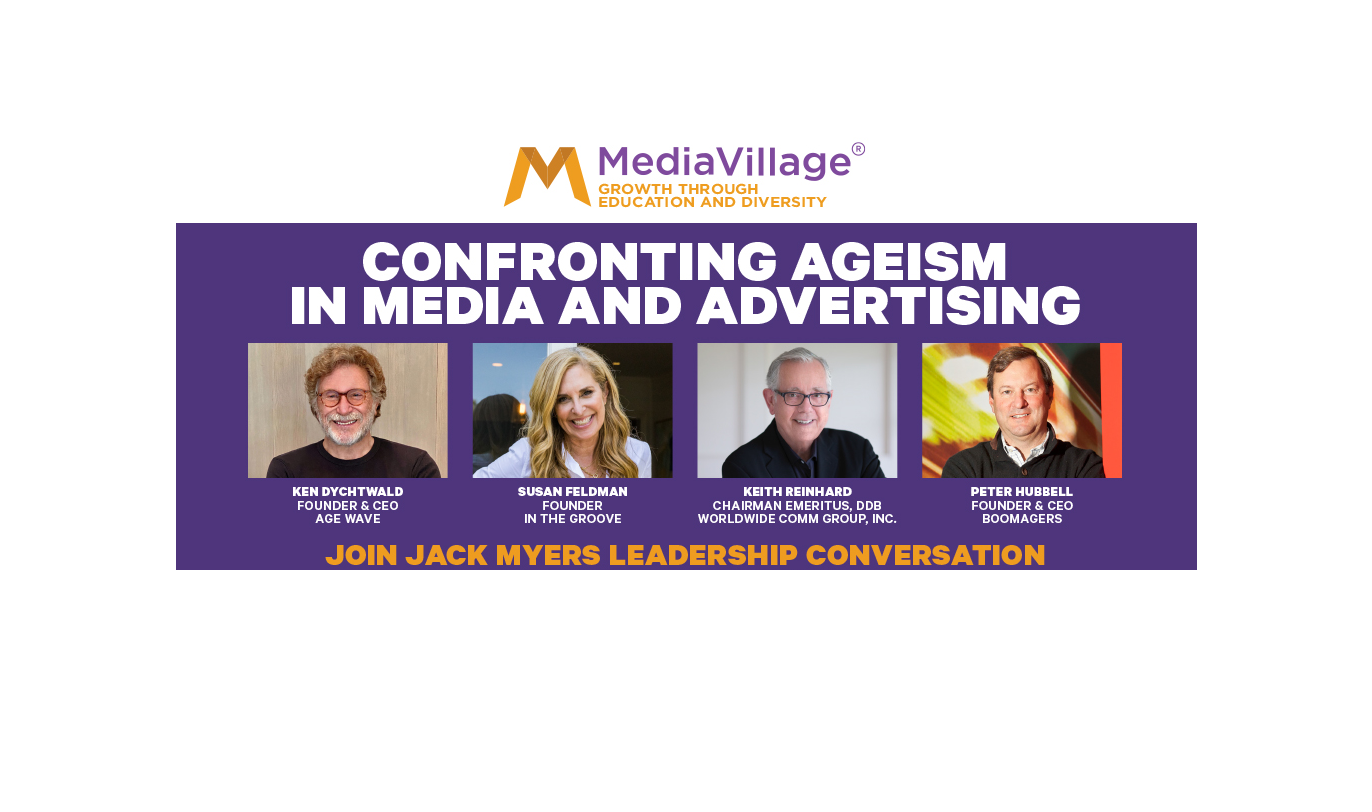Ken Dychtwald and Keith Reinhard on Creating a Cultural Sea-Change to Combat Ageism

The time for alibis is past: The ad industry needs to address its ageism problem immediately, a panel of industry luminaries recently concluded.
On September 22, the Jack Myers' Leadership Conversation Confronting Ageism in Media and Advertising, led by MediaVillage CEO Jack Myers, brought together BoomAgers CEO Peter Hubbell, In the Groove founder Susan Feldman, ageing expert Ken Dychtwald and DDB Worldwide Chairman Emeritus and agency legend Keith Reinhard to discuss why agencies and clients need to give up their search for the fountain of youth—and to bust some Boomer myths in the process. Watch the full conversation here.
The issue of ageism in media and advertising is a tangled one, a combination of several cultural threads that is in some respects a monster of the industry's own making.
After all, as Dychtwald pointed out, through as late as the 1950s youth was seen as a miserable time. "When you were young, you had no money, no power," he said. "It stunk." The angst of youth, combined with lower life expectancies for much of human history, meant advanced age was more of a status symbol.
Well, it did until Pepsi came in with a campaign geared toward young people, in an effort to snag market share from Coca-Cola. "'Everybody loves youth' was a marketing trick," Dychtwald said. "And it worked."
That trick has been so effective that even though study after study has proved that the formation of a brand identity is a myth, and that Boomers are no more brand-loyal than the most impulsive twentysomething.
"I'm not brand loyal," Dychtwald, who turned 70 a few months ago, said. "If I were, I'd still be wearing Hanes. I don't use any products I used when I was 25."
That's one big myth that has been busted. Another is that Boomers—and their elders—are Luddites, that their needs are limited to devices that help them get out of the tub. Dychtwald put up a series of slides that put this myth to rest as well. Consumers 55+ are responsible for:
- 41% of spend on women's apparel and personal care products
- 42% of groceries, new vehicles, and air travel
- 44% of housewares
- 55% of book purchases and OTC drugs
- 56% of spend on vitamins
- 67% of prescription drug spend
Adults over 55 control 69 percent of the wealth in America—and they aren't.
But then there's the economic thread. The cost pressures on agencies, in particular, are enormous, with clients often incentivizing more "efficient" uses of money like hiring two younger creatives for the same price as a more senior creative. This has resulted in what Reinhard calls the "juniorization" of agencies and has led to average employee ages well below 30.
The problem here is obvious. "If you're a pizza maker, you can keep cutting the quality of your pizza dough," Reinhard said. "Until someone doesn't buy your pizza." Although Reinhard loves the enthusiasm and energy and even genius of these younger employees, he doesn't think they're as capable of telling stories that cover the vast variety of life experiences the 55+ audience has.
So, how does the industry untangle the ageism knot?
Well, the trade press can certainly help, Reinhard said. Every other week, it seems, a new "30 Under 30" list of wunderkinds comes out, but where are the "40 Over 40" lists? "50 Over 50"? Studies about Millennials get instant play in the press; studies about Boomers, less so.
Another imperative is to get clients on board—agencies go where clients lead, and if clients can put away their fears about their brands seeming "old" (itself an ageist mindset), agencies will do the work to include the 55+ viewpoint. At stake are literally trillions of dollars, so the incentive for both parties is there.
For Dychtwald, a fundamental shift in the way we think about age in our culture is needed. "We've got a six-generation society," he said, but the advertising community is so laser-focused on youth that it leaves vast swaths of the country on the sidelines—or, worse, insists that people want to see idealized versions of themselves on-screen. "The idea that 55-year-old women want to be 30-year-olds is like saying people of color want to be white," Dychtwald said. "There's something wrong and mean and ignorant about it."
Pitting generations against each other is similarly wrong and ignorant, he adds. "There is no 'Boomer vs. Millennial'—how dumb are we that we feel the need to pick?" Dychtwald asserted. "We live in a world where we can market to multiple people at the same time. Generational fabrications are only sort of useful." In fact, the use of generational labels ends where marketing begins.
What Reinhard would like to see is a merging of the minds—combining the strengths of young geniuses with the life experience of the old masters. This integration, though, requires us to put aside our generational thinking.
Deprogramming this instinct to think generationally—and not simply generationally, but adversarially—is difficult on a large scale, but, Dychtwald argued, all the more essential.
"There's a lot of life going on out there," he said.
Also Read:Disproving Age Bias, In the Groove Captures Untapped Potential of Active 50+ Female Consumers by Raquelle Zuzarte
Click the social buttons to share this story with colleagues and friends.
The opinions expressed here are the author's views and do not necessarily represent the views of MediaVillage.com/MyersBizNet.


